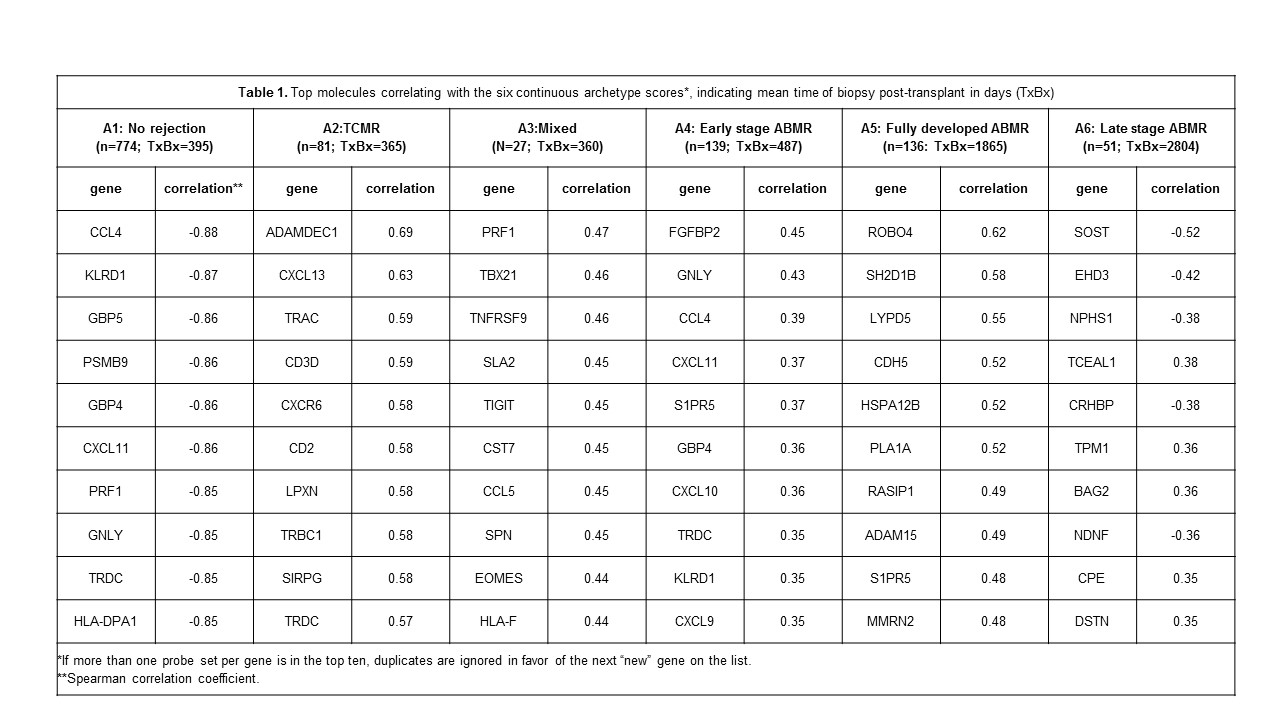The Molecular Phenotypes of Rejection in Kidney Transplant Biopsies.
University of Alberta, Edmonton, AB, Canada
Meeting: 2017 American Transplant Congress
Abstract number: 299
Keywords: Biopsy, Gene expression, Kidney, Rejection
Session Information
Session Name: Concurrent Session: Antibody Mediated Rejection in Kidney Transplant Recipients: Pathophsiology and Epidimiology
Session Type: Concurrent Session
Date: Monday, May 1, 2017
Session Time: 4:30pm-6:00pm
 Presentation Time: 5:06pm-5:18pm
Presentation Time: 5:06pm-5:18pm
Location: E354a
In a microarray analysis of 1208 kidney transplant indication biopsies, each biopsy was assigned molecular scores for seven phenotypes related to various aspects of TCMR, ABMR, and overall rejection. These scores were then combined using archetype analysis, an unsupervised method related to clustering. This analysis indicated that molecular rejection is best explained by 6 archetypal states. Each biopsy is assigned a score reflecting proportional membership in each state, and the state receiving the highest score is assigned as that biopsy's molecular phenotype. The six states were: A1:No rejection; A2:TCMR; A3:mixed TCMR/early stage ABMR, with elements suggesting non-adherence; A4:early stage ABMR; A5:fully developed ABMR; A6:late stage ABMR.
We examined the top transcripts correlated with each of the six sets of archetype scores. A1:No rejection was defined by lack of IFNG effects (e.g. CXCL11) and shared T/NK transcripts (e.g. KLRD1 ) (Table 1). A2:TCMR was strongly associated with myeloid cell activation e.g. ADAMDEC1, CXCL13. A3:Mixed was associated with an increase in T/NK gene expression. A4:Early stage ABMR was associated with the NK genes FGFBP2, GNLY, and CCL4, but not with CD160. A5:Fully developed ABMR was dominated by endothelial activation genes (e.g. ROBO4) and the NK structural gene SH2D1B. A6:late stage ABMR was dominated by the low expression of genes that probably reflect de-differentiation of microcirculation (less SOST/sclerostin) and glomeruli (less NPHS1/nephrin). The progression of the three ABMR phenotypes – early stage to fully developed to late stage – probably represents the natural history of ABMR, from NK-IFNG-rich to full ABMR with endothelial remodeling features to late stage with microcirculation de-differentiation. These states may also reflect different intensities in ABMR processes, giving different rates of progression and probabilities of presenting with clinical findings. 
CITATION INFORMATION: Halloran P, Reeve J, INTERCOMEX Study Group The Molecular Phenotypes of Rejection in Kidney Transplant Biopsies. Am J Transplant. 2017;17 (suppl 3).
To cite this abstract in AMA style:
Halloran P, Reeve J, Group INTERCOMEXStudy. The Molecular Phenotypes of Rejection in Kidney Transplant Biopsies. [abstract]. Am J Transplant. 2017; 17 (suppl 3). https://atcmeetingabstracts.com/abstract/the-molecular-phenotypes-of-rejection-in-kidney-transplant-biopsies/. Accessed December 11, 2025.« Back to 2017 American Transplant Congress
